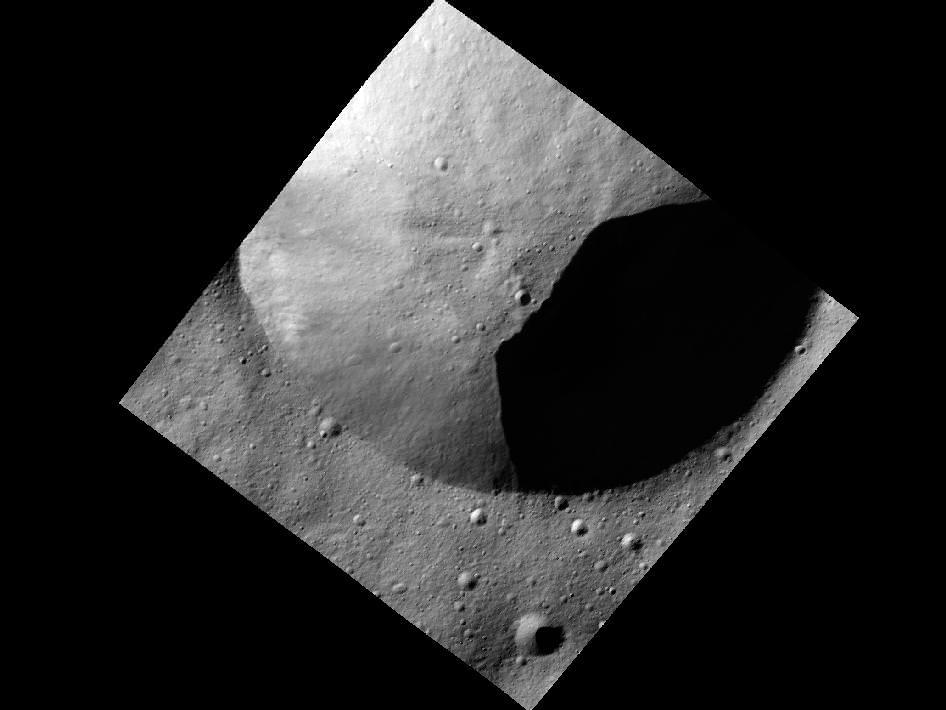[/caption]
NASA's
Dawn spacecraft
has swooped down to the closest orbit above the monster asteroid
Vesta
that the craft's cameras and spectrometers will ever glimpse and the probe has begun transmitting these
highest resolution pictures
to anxiously waiting scientists back on Earth.
Dawn
arrived at its Low Altitude Mapping Orbit, known as LAMO, on Dec. 12, 2011 and will continue circling scarcely 130 miles (210 kilometers)
above Vesta
for at least the next 10 weeks. Each orbit takes about 4.3 hours.
NASA
has now released the first batch of crisp new close-ups images taken by the Framing Camera on Dec. 13 showing the stippled and lumpy surface in an exquisitely fine detail never seen before.
The photo montage below shows side by side views of the same portion of the Vestan surface at ever increasing resolution and clarity from ever lower altitudes.
[caption id="attachment_92077" align="aligncenter" width="580" caption="Closer and Closer to the Vesta Surface NASA's Dawn spacecraft has spiraled closer and closer to the surface of the giant asteroid Vesta since arriving in mid-2011. The two images on the left represent an identical area, first observed during Dawn's survey orbit (far left image). The picture in the center is from Dawn's high-altitude mapping orbit (HAMO) from an altitude of about 430 miles (700 km) with about 230 feet (70 meters-per-pixel) resolution. The image at right was obtained on Dec. 13 from the low altitude mapping orbit (LAMO) at an altitude of 124 miles (199 km) above the surface and has a resolution of 75 feet (23 m) per pixel. It shows small impact craters or slumping at the steep-flanked mountain in the image center that can be identified in the two images to the left. Credit: NASA/JPL-Caltech/UCLA/MPS/DLR/IDA"]
[/caption]
The high resolution image gallery reveals fine scale highlights such as multitudes of small craters, grooves and lineaments, landslides and slumping, ejecta from past colossal impacts, and small outcrops of bright and dark materials.
The science team, led by Principal Investigator Prof Chris Russell of UCLA, believes that Vesta is actually more like a planet than an asteroid based on the data obtained thus far.
"
Vesta
is the smallest terrestrial planet in our Solar System", Russell told Universe Today. "We do not have a good analog to
Vesta
anywhere else in the Solar System."
The primary science objectives at the LAMO orbit are to measure the elemental abundances on the
surface of Vesta
with the US built gamma ray and neutron detector (GRaND) and to probe the interior structure of the asteroid by measuring the gravity field.
Vesta is a proto-planet formed just a few million years after the birth of the solar system whose evolution into a larger planet was stopped cold by the massive gravitational influence of the planet Jupiter.
Scientists are plowing through thousands of images and millions of spectral measurements to glean clues about the origin and evolution of the solar system that have been preserved on the hitherto unexplored world.
[caption id="attachment_92080" align="aligncenter" width="580" caption="Buried Craters on Vesta This Dec. 13 image from Dawn spacecraft in its low altitude mapping orbit shows many buried craters located within the equatorial trough region of Vesta. This area bears traces of the material thrown out by the impact that created the Rheasilvia basin in the asteroid's south polar region. Lineated features are visible in a variety of shapes and sizes from an altitude of 117 miles (189 km) over an area of 11 mi x 11 mi (18 km x 18 km). Credit: NASA/JPL-Caltech/UCLA/MPS/DLR/IDA"]
[/caption]
"Vesta is a transitional body between a small asteroid and a planet and is unique in many ways," says mission scientist Vishnu Reddy of the Max Planck Institute for Solar System Research in Katlenburg-Lindau, Germany. "Vesta is unlike any other asteroid we have visited so far."
After completing the LAMO measurements,
Dawn
will again spiral back to a higher altitude for further data gathering especially at the unseen North Pole which is in darkness now.
Dawn
will continue orbiting Vesta until July 2012 when it will fire up its ion propulsion system and depart for
Ceres
, the largest body in the main Asteroid belt between Mars and Jupiter.
"What can be more exciting than to explore an alien world that until recently was virtually unknown!" Dr. Marc Rayman told Universe Today. Rayman is Dawn's Chief Engineer from NASA's Jet Propulsion Lab (JPL) in Pasadena, Calif.
[caption id="attachment_92079" align="aligncenter" width="575" caption="Equatorial Trough in Dark and Bright on Vesta This image was one of the first obtained by Dawn in its low altitude mapping orbit and shows a part of one of the long troughs at the equator of Vesta. Credit: NASA/ JPL-Caltech/ UCLA/ MPS/ DLR/ IDA"]
[/caption]
"Dawn continues to gather gamma ray spectra and neutron spectra," Rayman reports. "The bonus imaging at LAMO is yielding pictures more than three times better than those acquired in the high altitude mapping orbit (HAMO). Every week at this low altitude, Dawn will use its ion propulsion system to fine tune its orbit. The first of these weekly orbit adjustments was performed on December 17."
The framing cameras eere built by the Max Planck Institute for Solar System Research in Germany.
A treasure trove of spectacular Vesta close-ups are streaming at this moment to the home planet and we'll have many more goodies to show.
Read continuing features about Dawn by Ken Kremer starting here:
Holiday Greetings from an Alien Snowman on Vesta
Dawn swoops to lowest orbit around Vesta – Unveiling Spectacular Alien World
Rainbow of Colors Reveal Asteroid Vesta as More Like a Planet
Vrooming over Vivid Vestan Vistas in Vibrant 3 D – Video
NASA Planetary Science Trio Honored as 'Best of What's New' in 2011- Curiosity/Dawn/MESSENGER
Dawn Discovers 2nd Giant South Pole Impact Basin at Strikingly Dichotomous Vesta
Amazing New View of the Mt. Everest of Vesta
Dramatic 3 D Imagery Showcases Vesta's Pockmarked, Mountainous and Groovy Terrain
 Universe Today
Universe Today
